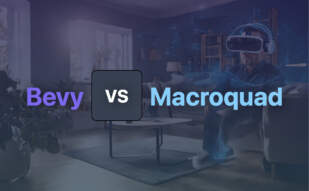Macroquad is a versatile game library for Rust, featuring highly efficient 2D rendering, rapid build times, and cross-platform support. With a minimalistic design perfect for beginners, it offers a UI library, immediate mode, and supports various platforms effortlessly.

Looking for alternatives to Macroquad? Explore options such as Bevy, Amethyst, Boundless, MonoGame, Raylib, Piston, Godot, Unity, Unreal Engine, Fyrox, and Brilliant.
Bevy
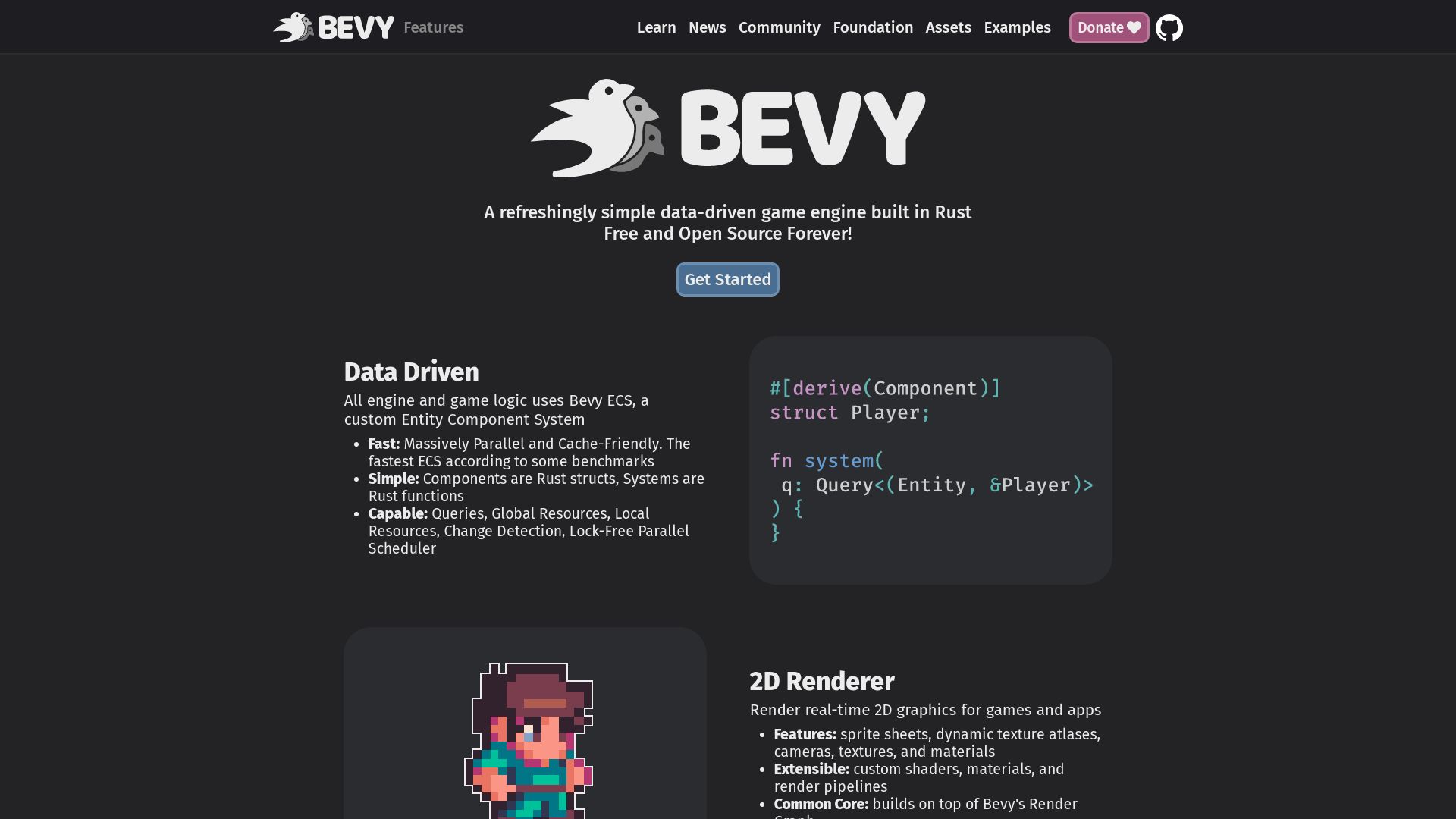
Meet Bevy, a data-driven game engine constructed in Rust. Renowned for its complete 2D and 3D feature set and a focus on data-oriented architecture, Bevy capitalizes on the Entity Component System (ECS) paradigm.
Bevy Top Features
- 2D and 3D rendering: This feature adds depth and intrigue to your gaming project.
- User Interface functionality: His provides essential controls for game navigation and interaction.
- Sound loading and hot reloading: Get instant feedback for changes, enabling efficient testing and adjustments.
- Multi-platform support: Compatibility with major platforms —Windows, MacOS, Linux, Web, iOS. Android support forthcoming.
| Feature | Description |
|---|---|
| Fast Compile Time | Bevy boasts a speedy compile time of between 0.8-3.0 seconds, ensuring rapid feedback and development. |
| Community Options | A strong community base with various interaction opportunities. Engage via a Discord server, subreddit, GitHub Discussions, and Bevy Assets collection. |
| Bespoke Cargo Features | Bevy offers customisable cargo features, moulding its functionality around your specific needs. |
Bevy Limitations
- API can break due to dependency on Rust language and compiler improvements.
- Modern web standards like wasm and webgpu are still under consideration.
- Lack of Android support: This platform is not yet supported, but it’s on the roadmap.
Bevy Pricing
Bevy is open-source and free. It operates under the permissive MIT or Apache 2.0 licenses.
Bevy Use Cases
Use Case 1: Indie game developers
With a compact binaries size (a little over 1MB) and the openness of source code, Bevy empowers indie developers to build rich and optimised games.
Use Case 2: Enthusiasts
Bevy promises a swift feedback cycle due to rapid compile times. This feature, combined with the engine’s ease of use, makes it an attractive choice for gaming aficionados.
Use Case 3: Large studios
Ambitions for high-level and low-level networking and a Bevy-powered editor make the platform a tempting future consideration for bigger studios.
Amethyst
Meet Amethyst, a game engine originally designed to be data-driven and data-oriented with a core focus on multi-threading. While development has currently halted, Amethyst remains an attractive option for beginners and developers looking for rapid prototyping capabilities.
Amethyst Top Features
- Massively parallel architecture
- Entity Component System (ECS)
- Excellent compatibility with Rust v1.47
- Focused on reusability and clean interfaces
- Ideal for rapid prototyping
| Feature | Description |
| Multi-threaded Design | Amethyst’s architecture is tailored for massively parallel processing. |
| Rust Language | Amethyst leverages Rust’s superior concurrency and game development capabilities. |
| Developer Community | Amethyst offers a responsive developer community via Discord to aid users in finding solutions. |
Amethyst Limitations
- Limited compatibility, primarily with Rust 1.47.
- Development halts may compromise planned updates and bug fixes.
- Not recommended for big commercial projects due to current pre-release status.
Amethyst Pricing
The Amethyst game engine is an open-source offering, freely available for use.
Amethyst Use Cases
Use Case 1: Small-Scale Game Development
Amethyst’s focus on rapid prototyping, reusability of components, and a clean interface makes it an ideal game engine for small-scale game development and personal projects.
Use Case 2: Beginners Learning Game Development
With comprehensive documentation, a strong community for support, and a user-friendly operation, Amethyst is perfect for grooming a beginner’s understanding of game development.
Use Case 3: Prototyping
Given its strong focus on rapid prototyping, Amethyst stands as a solid option for developers looking to quickly manifest their game ideas in a tangible form.
Brilliant
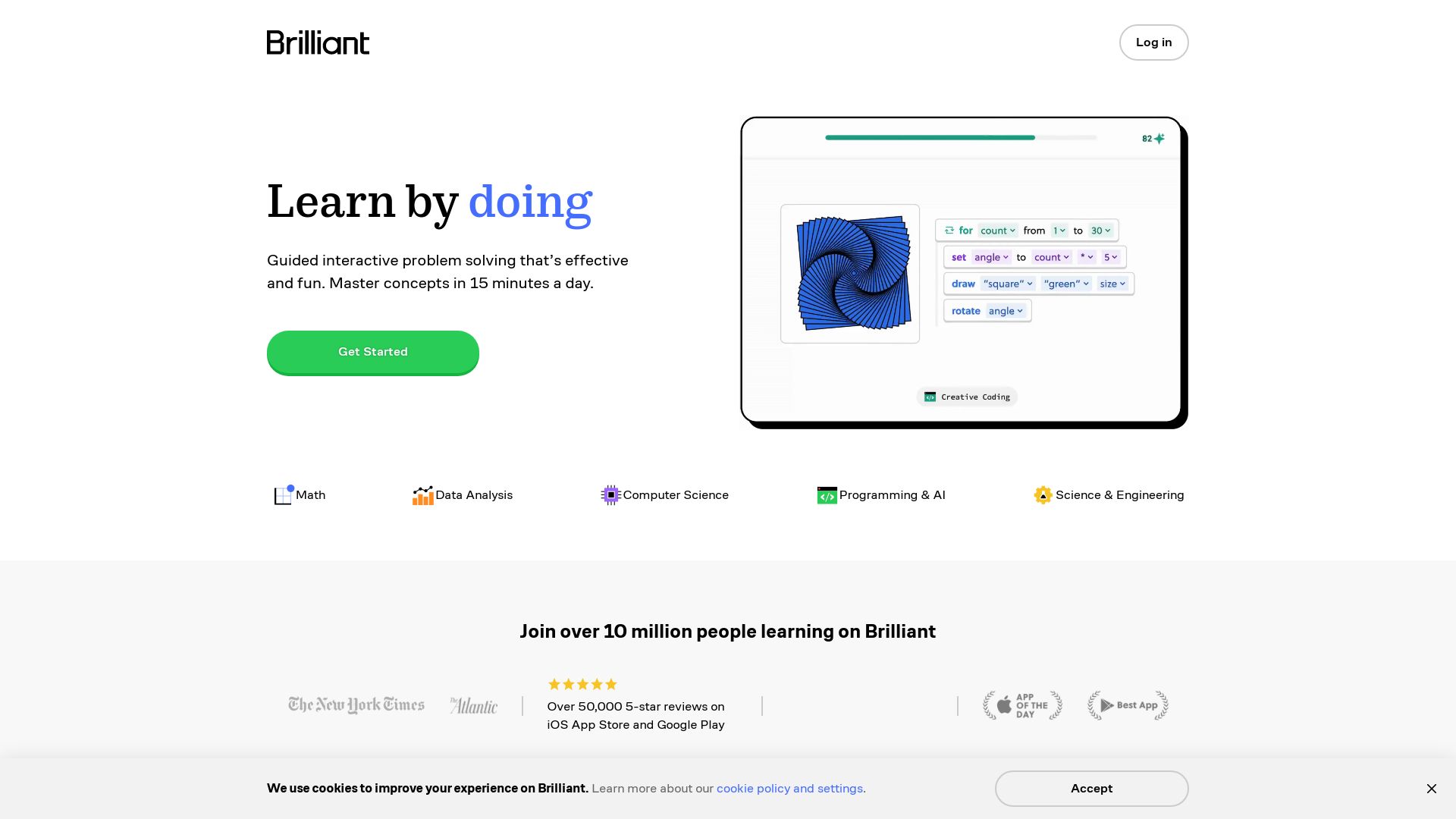
Established in 2012, Brilliant is a United States-based educational platform thatspecializes in STEM topics. With a user base exceeding 4 million, it offers over 100 guided courses across a broad spectrum of STEM fields.
Brilliant Top Features
- Gamified Learning: Brilliant replaces monotonous lectures with interactive puzzles & games, facilitating an easy understanding of complex concepts.
- Quality Content: Courses are created by professionals, researchers, and educators from esteemed institutions.
- Visual Aids: Brilliant leverages the use of visual aids to portray difficult topics.
- Daily Challenges: The platform offers daily challenges to keep users consistently engaged.
- Customized User Experience: Brilliant tailors its learning experience based on a user’s interests & aptitude levels.
| Feature | Description |
|---|---|
| Impressive Course Range | Brilliant offers courses spanning from fundamentals to advanced topics like special relativity, quantum objects. |
| Platform Availability | The platform is accessible across multiple devices such as tablets, smartphones, computers, and laptops. |
| Proactive Customer Support | Brilliant houses a dedicated Help Center and fosters an interactive learning community. |
Brilliant Limitations
- No formal accreditation or certificates offered upon course completion.
- Community submissions of new puzzles and solutions were discontinued in 2021.
- All courses are not freely accessible; only a few lessons are available for free.
Brilliant Pricing
Brilliant operates on a freemium model where some lessons are free to access. For complete access to all lessons, users can subscribe to a premium membership priced at $24.99/monthly or a discounted $13.49/monthly for an annual subscription.
Brilliant Use Cases
Use case 1: Students
Given Brilliant’s wide range of courses and interactive teaching methodology, it serves as a valuable resource for students to comprehend complex STEM topics efficiently.
Use case 2: Educators
Educators can continually supplement classroom learning using Brilliant. The platform offers a chance for educators to attain free access, thereby making it a beneficial teaching aid.
Use case 3: Professionals & Hobbyists
Professionals and hobbyists in the STEM field can leverage Brilliant’s problem-solving courses to upskill and hone their knowledge effectively.
Boundless

Boundless is a leading player in the Augmented Reality (AR) and Virtual Reality (VR) sphere, with a wide range of applications spanning from real estate and healthcare to education and gaming.
Top Features of Boundless
- Immersive AR/VR experiences tailored for architecture and real estate, providing virtual property tours and design visualizations.
- Innovative healthcare applications, including virtual surgical practices and medical student training.
- AR/VR integration into manufacturing and engineering processes to enhance productivity and streamline operations.
- Revolutionary educational aids offering interactive learning experiences, from visualizing complex subjects to making remote learning more engaging.
| AR Applications | VR Applications |
|---|---|
| Overlays digital elements on the real world | Creates immersive, artificial environment |
| Increased engagement in education, healthcare, and remote collaboration | Enhanced immersion in gaming, entertainment, and training simulations |
Limitations of Boundless
- Access to technology may be a barrier for users without the requisite digital infrastructure or high-end mobile devices.
- A hefty cost can be associated with the adoption and implementation of AR/VR solutions.
- The need for skilled educators or professionals to effectively deploy and utilize the technology.
Boundless Use Cases
Use Case 1: Real Estate and Architecture
In the sphere of architecture and real estate, Boundless allows developers and potential buyers visual property tours, thereby enhancing decision making.
Use Case 2: Healthcare
Boundless‘s AR/VR solutions enable surgeons to practice complex procedures virtually, therefore reducing risks and enhancing the overall quality of healthcare.
Use Case 3: Education
Boundless‘s AR/VR solutions prove crucial in providing interactive learning experiences, especially in subjects like anatomy and geography where visualizing complex subjects is key.
MonoGame

MonoGame is a free, open-source C# framework initially released in September 2009, boasting cross-platform capability for game development. Originated from XNA Touch and Silver Sprite, it’s a popular choice for developers, learner and expert alike.
MonoGame Top Features
- Multiple platform support including iOS, Android, macOS, tvOS, Linux, PlayStation 4, Vita, Xbox One, Nintendo Switch.
- Successful reinvention of the Microsoft XNA 4 API.
- Empowering independent developers with control over game development process.
- Offering 2D and improved 3D support from mid-2013.
- Features a community maintained engine.
| Feature | Description |
|---|---|
| Real-world applicability | Examples include games like Bastion, Dust: An Elysian Tail, Stardew Valley, and Transistor |
| Courses and tutorials based on C# | MonoGame courses cater to aspiring developers while including comprehensive lessons on mathematics, geometry, and computer graphics |
MonoGame Limitations
- Not suitable for developers seeking a WYSIWYG environment or integrated game editor.
- Limited to basic C# programming knowledge.
- Outdated XNA, not optimized for non-Windows platforms.
- Infrequent updates and lack of high-level programming.
MonoGame Pricing
As a free and open-source framework, MonoGame is accessible for all. It does, however, require paid support for iOS and Android.
MonoGame Use Cases
Use case 1
MonoGame, with its cross-platform support, offers a powerful game development platform for developers targeting multiple platforms, from consoles to smartphones.
Use case 2
For developers intending to handle lower-level programming tasks and control over the game development process, MonoGame serves as an ideal tool.
Use case 3
Budding developers with basic C# knowledge can leverage MonoGame’s community support, courses, and tutorials to build 2D and 3D games.
Raylib
Established by Ramon Santamaria and his team since 2013, Raylib is a cross-platform toolset, steeped in C-based language and augmented with OpenGL. Renowned for its vivid graphics and immersive 3D capabilities, Raylib has become a trusted cornerstone in game engine technology.
Raylib Top Features
- Powerful Fonts module supporting various formats like SpriteFonts, BMfonts, TTF, SDF
- Comprehensive 3D support with flexible materials system including classic and PBR maps
- Exclusive OpenGL abstraction layer: rlgl
- Math module for Vector, Matrix and Quaternion operations: raymath
- Immediate mode GUI module: raygui
| Feature | Description |
|---|---|
| Hardware acceleration | Features hardware acceleration with OpenGL |
| VR Rendering | Offers VR stereo rendering with adjustable HMD device parameters |
| Audio Support | Facilitates audio loading and streaming (WAV, OGG, MP3, FLAC, XM, MOD) |
Raylib Downsides
- Lacking in external dependencies as all required libraries are included.
- Raylib technologies focus has shifted more towards tools development, reducing the focus on the more traditional aspects of the platform
Raylib Pricing
Revelling in the spirit of open-source networks, Raylib offers its profound mechanisms and frameworks at no cost. It’s completely free, promoting accessibility and innovation amongst developers.
Raylib Use Cases
Use case 1
Raylib’s lightweight and comprehensive toolset makes it ideal for game developers aiming to create prototypes and actual games.
Use case 2
Its powerful Fonts module and flexible material systems are beneficial for graphical applications, offering designers a comprehensive resource for creative development.
Use case 3
The platform’s cross-platform functionality and hardware acceleration capabilities make it a suitable choice for embedded system development, offering a streamlined workflow for developers.
Piston
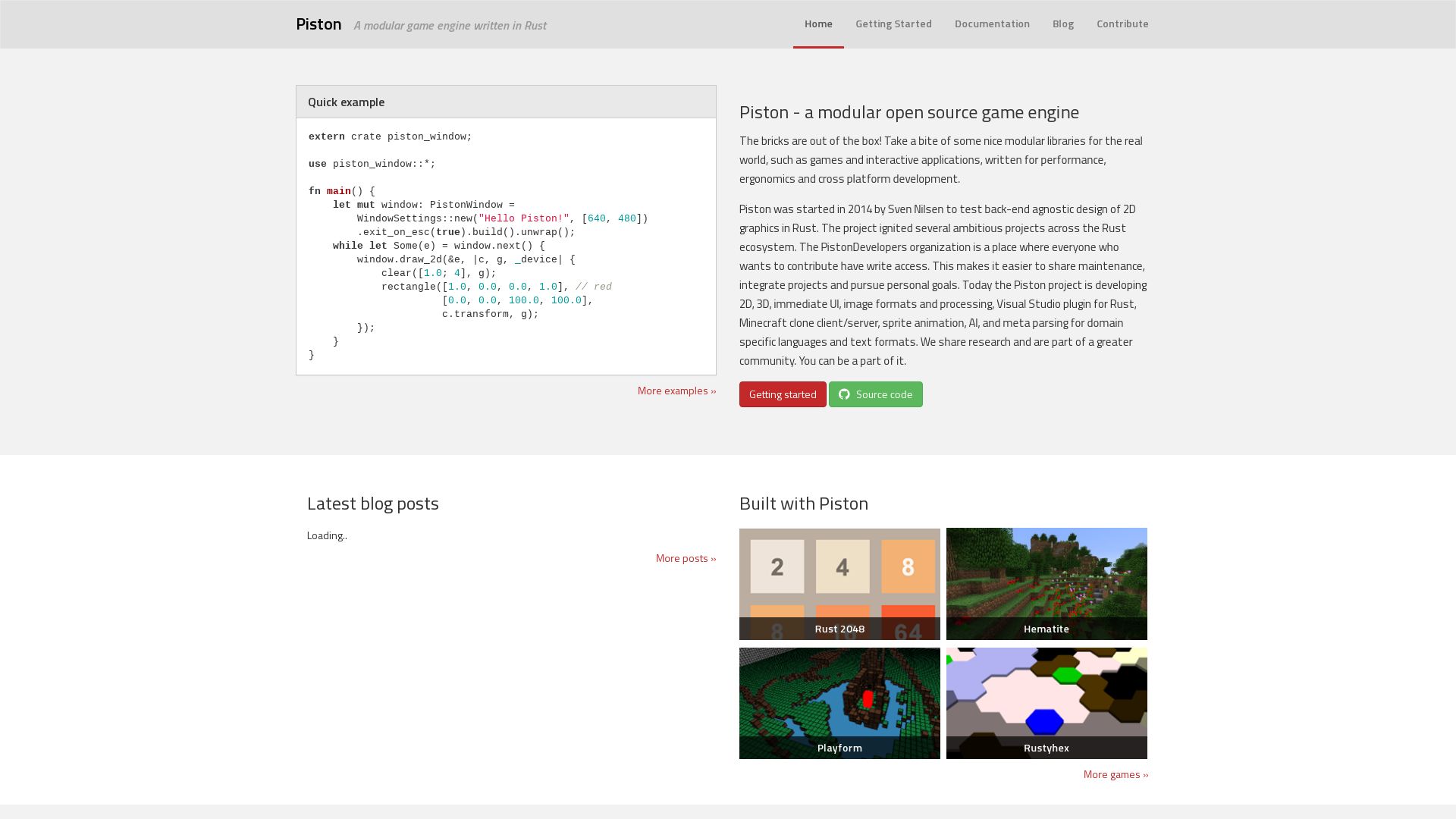
Emerging from the innovative realm of game engine development is the intriguing entity of Piston. Specialising in Rust, Piston is designed with utmost modularity. Its focus on specialized tasks allows a broad usage of Rust’s ecosystem libraries and encourages active engagement in open-source activities.
Piston Top Features
- Crafted with Rust, providing robust memory management, preventing data races, and leveraging concurrency features.
- Adopts the Model-View-Controller (MVC) pattern for easy and efficient application writing.
- Distinct features including GenericEvent for intuitive event handling and Window for smooth event polling.
- Essentially modular, permitting the use of any library from Rust’s ecosystem.
- Offering different window backends like pistoncore-glutin_window, pistoncore-sdl2_window, and pistoncore-glfw_window.
| Distinct 2D Graphics Backends | piston2d-opengl_graphics, piston2d-gfx_graphics, piston2d-glium_graphics |
| Audio and 3D Graphics Collaboration | Collaboration with Gfx-rs and RustAudio enhances audio-graphics synchronization |
| Application-specific UI | Highly rated (4.6 on Apple Store) – ‘Engine Pistons ASMR’ |
Piston Limitations
- Event handling and 2D graphics require understanding of Points vs Pixels.
- Project stability is aimed for future updates; core remains unchanged since inception in 2014.
- Dyon scripting language, despite simplicity, might be daunting for non-programmers.
Piston Pricing
Being a part of a collaborative open-source project, Piston is freely available to all developers who seek to venture into the realm of game development using Rust.
Piston Use Cases
Use Case 1: Game Development
With its compatibility with the ecosystem of Rust’s libraries and robust memory management, Piston is an excellent choice for Game Development.
Use Case 2: 2D/3D Graphics
Piston comfortably handles 2D/3D graphics making it apt for projects with rigorous graphical demands.
Use Case 3: Open Source Engagement
Piston’s engine, being open-source, provides vast opportunities for those interested in contributing to open-source projects.
Godot
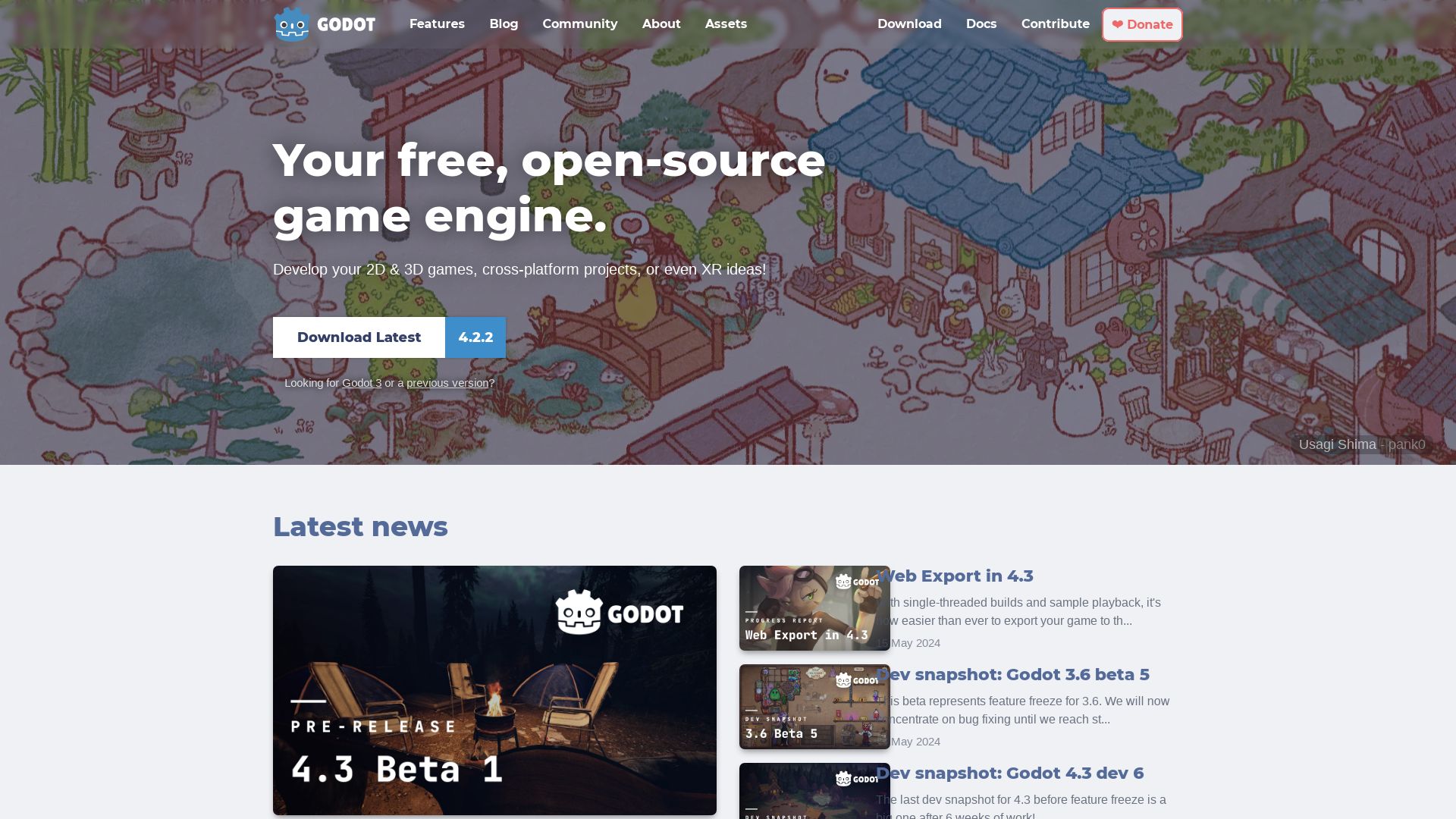
Make way for Godot, your free, open-source game engine, known for its flexibility, intuitive design, and powerful scene-driven design. Loved globally for its MIT licensing, this engine packs punch and prowess, without burning a hole in your pocket.
Godot Top Features
- Multifaceted Features: Capabilities range from scene creation with simple blocks, leveraging nodes for complex scenes, and combining scenes into glamorous components.
- Enjoy Godot’s engine tight integration for a streamlined game logic and its 2D workflow specialization.
- Looking for language diversity? Godot’s got you covered with official support for C++, built-in GDScript, or choose from community-supported languages like Rust, Nim, Python and more.
- Offering cross-device compatibility, Godot’s 3D engine sustains high and low-end devices alike.
- Coupled with the ability to import Blender files directly and a built-in visual editor, this engine knows no bounds.
| Additional Features | Description |
|---|---|
| Modifiable Codebase | Customize your world of gaming with its open source codebase under the MIT license. |
| Node System | Create games with the smallest building blocks using the node system or layout complex scenes with ease. |
Godot Limitations
- Before you empty your entire war chest, be warned. Godot may not be your first choice for complex 3D game development.
- Also, note that currently, Godot’s .NET support is only available for desktop platforms in the 4th version.
Godot Pricing
Surf’s up and the ride is free! Yes, you heard right. Godot is free under the MIT License. No hidden fees, no contracts, just pure coding ecstasy.
Godot Use Cases
Indie Game Development
With its agility, flexibility, and feature diversity, Godot is a prime choice for indie game developers looking for a cost-effective solution.
Educational Purposes
Godot’s inclusive language support and customizable open-source codebase make it an excellent tool for students to learn and experiment with game development.
Professional Game Development
Wide platform support, powerful engines, and continuous community-driven development give Godot an edge for professional game developers.
Unity

Launched in 2005, Unity has emerged as an indispensable cross-platform game development engine, notable for its adaptability and high-quality rendering technology.
Unity Top Features
- Enables launch of cross-platform games including Android and iOS platforms.
- Versatile with various operating systems, offering a wide array of applications, including Augmented Reality to 3D simulations.
- Rich asset store integrated with pre-designed textures, fueling innovative game designs.
- Active developer community for rapid problem-solving and constructive feedback.
- Supports multiple coding languages including BOO script, Javascript, and C#.
| Pro Version | Enhanced features for sophisticated game development |
| Training Resources | Consistent learning and application of new industry solutions |
| Tech evolution | Frequent updates to improve user-friendliness, compatibility, and immersive visual experiences |
Unity Downsides
- Sudden changes and unannounced fee structures have led to distrust among users.
- The new pricing model, effective January 1, 2024, could hamper financial sustainability for developers.
- Concerns over potential abuse of per-install fees, including repeated downloads by one user, remain unresolved.
Unity Pricing
Unity will usher in a new pricing model from January 1, 2024, with developers charged each time their game using Unity is installed, kicking in after the game surpasses $200,000 in revenue and 200,000 installations. Unity also offers both free and Pro versions.
Unity Use Cases
Use case 1: Game Development
Unity is widely preferred for its facilitation of cross-platform game development and high-quality rendering capabilities.
Use case 2: Augmented Reality
Unity has carved a niche in the creation of revolutionary AR/VR games, empowering developers with innovative tools and features.
Use case 3: Learning Platform
Unity serves as an educational tool, engaging users in the learning and implementation of new industry solutions.
Unreal Engine
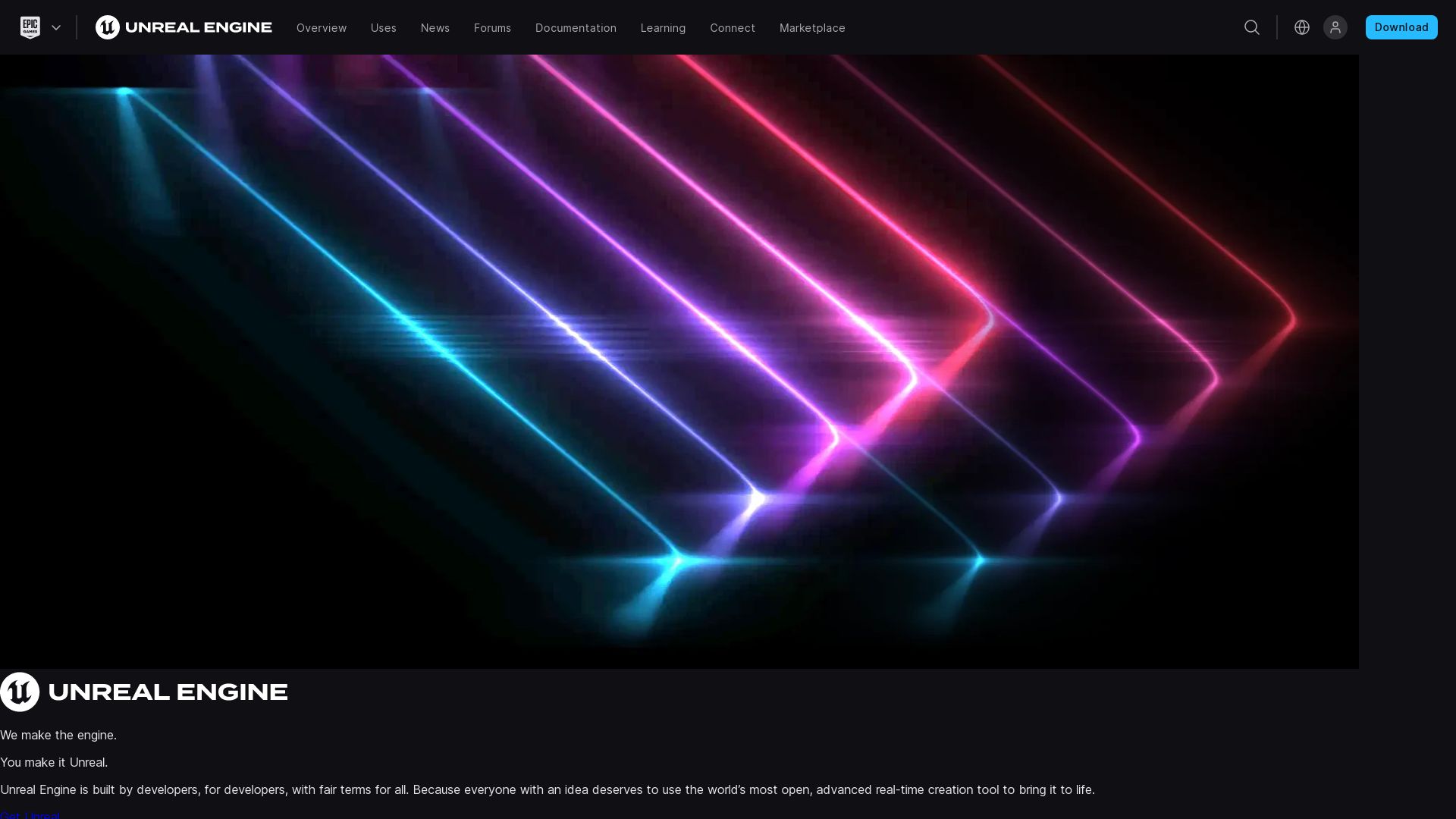
Enter the world of Unreal Engine (UE), a powerhouse of 3D computer graphics game engines sculpted by Epic Games. Historically dating back to 1998, its first spectacular showcase was illustrated in a PC first-person shooter game, namely Unreal. Since then, it has continuously evolved, catering to an array of multiple game genres and industries, marking a momentous presence in film and television.
Unreal Engine Top Features
- Wide-Range Support: Scripted in C++, UE offers support for a broad spectrum of platforms, from desktop to mobile, console to virtual reality.
- UnrealEd: Comes bundled with a sophisticated level editor that enables real-time constructive solid geometry operations.
- Unreal Development Kit: A free version of UE3’s SDK, encouraging developers with the ability to create iOS games and apps.
- Marketplace: For selling and buying developers creations, with an impressively high revenue sharing proportion of 88% going to content creators.
- Education-Friendly: UE is pro-education as it offers its services free for both schools and universities.
| Version | Launch year |
|---|---|
| Unreal Engine 5 | 2022 |
| Unreal Engine 4 | 2004 |
| Unreal Engine 3 | First showcased in 1998 |
Unreal Engine Limitations
- UE might involve a steeper learning curve, predominantly due to the complexity of C++ language employed for programming.
- Commercially used products must pay a 5% royalty on revenues over USD 1 million.
Unreal Engine Pricing
Primarily, Unreal Engine is free for all users. However, for commercially used products with revenues exceeding USD 1 Million, a royalty of 5% must be paid. The royalty stipulation, however, does not apply to games published on the Epic Games Store.
Unreal Engine Use Cases
Use case 1 – Game Development
From top-notch graphics to detailed environment models, Unreal Engine’s feature-rich environment is a go-to for game developers seeking to create immersive and interactive experiences. Its power in handling complex geometries and physics simulations makes it an ideal choice for developing visually stunning games in multiple genres – from first-person shooters to real-time strategy games.
Use case 2 – Film and Television Industry
Unreal Engine also finds significant applications in the film and television industry. The real-time rendering and extensive control over visual effects offered by Unreal Engine make it possible to create and showcase highly realistic scenes and animations for movies or TV shows.
Use case 3 – Education
As Unreal Engine is free for educational institutions, it is an effective tool for schools and universities seeking to introduce their students to game development or 3D computer graphics. Its dynamic and practical interface provides a hands-on understanding of these complex fields.
Fyrox
Fyrox, a highly competent 2D/3D game engine, stands out with its advanced asset management, remarkable cross-platform compatibility, and a wealth of features to enhance game development.
Fyrox Top Features
- Highly versatile: Fyrox hosts a native editor that’s comparable to Godot. It also supports a wide array of texture formats including PNG, JPG, BMP, and DDS.
- Cross-Platform Ready: Fyrox, designed with compatibility in mind, supports Windows, Linux, macOS, WebAssembly, and even Android.
- Powerful Asset Management: Advanced features like async asset loading, support for various audio and visual texture formats, and an advanced asset manager are cornerstone features of Fyrox.
- Efficient Audio Enhancements: The game engine utilizes audio buses, an audio bus graph, and supports sound buffers for sources in WAV and OGG.
- Dynamic Animation Techniques: Fyrox provides support for animation blending, root motion, and blend space. It also incorporates the ability to animate material properties and implement blend shapes for dynamic 3D mesh changes.
| Feature | Details |
|---|---|
| Sound Formats | Supports WAV, OGG format |
| Texture Formats | Supports PNG, JPG, BMP, DDS |
| Platform Compatibility | Windows, Linux, macOS, WebAssembly, Android |
Fyrox Disadvantages
- No explicit mention of VR support, which is an increasingly popular feature within the gaming industry.
- Though comprehensive, the considerable list of features may overwhelm beginners to game development engines.
Fyrox Pricing
As per the company summary, Fyrox does not mention any specific pricing structure. Therefore, interested developers should reach out to the company directly for details.
Fyrox Use Cases
Use Case 1: Small Game Development Studios
With its powerful feature set and cross-platform compatibility, Fyrox proves ideal for small to medium game development studios seeking a robust and adaptable game engine.
Use Case 2: Independent Game Developers
Thanks to its community support through Discord and Patreon, Fyrox provides a user-friendly environment for independent game developers.
Use Case 3: Educational Programs
The wealth of learning materials, including an official Fyrox book and multiple online tutorials, make the platform a compelling choice for educational programs focusing on game development.
Tiffany Brise
Content writer @ Aircada, patiently awaiting a consumer AR headset that doesn’t suck.



